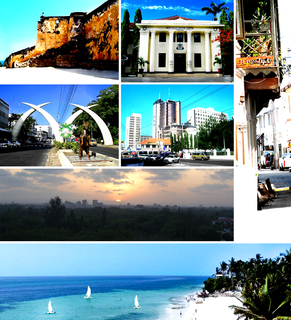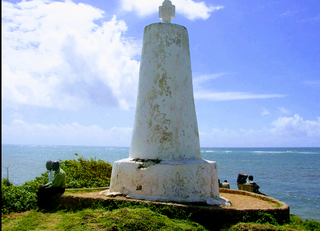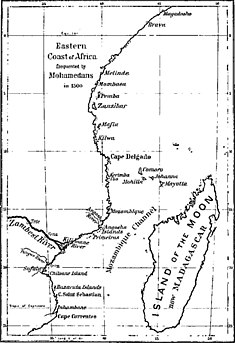
Swahili, also known by its native name Kiswahili, is a Bantu language and the native language of the Swahili people. It is one of two official languages of the East African Community (EAC) countries, namely Burundi, Kenya, Rwanda, South Sudan, Tanzania, Uganda, and the recently added Democratic Republic of the Congo. It is a lingua franca of other areas in the African Great Lakes region and East and Southern Africa, including some parts of the Democratic Republic of the Congo (DRC), Malawi, Mozambique, the southern tip of Somalia, and Zambia. Swahili is also one of the working languages of the African Union and of the Southern African Development Community. The exact number of Swahili speakers, be they native or second-language speakers, is estimated to be between 50 million to 150 million.

Mombasa is a coastal city in southeastern Kenya along the Indian Ocean. The city is known as the white and blue city in Kenya. It is the country's oldest and second-largest city, with a population of about 1,208,333 people according to the 2019 census. Its metropolitan region is the second-largest in the country, and has a population of 3,528,940 people.

Dhow is the generic name of a number of traditional sailing vessels with one or more masts with settee or sometimes lateen sails, used in the Red Sea and Indian Ocean region. Typically sporting long thin hulls, dhows are trading vessels primarily used to carry heavy items, such as fruit, fresh water, or other heavy merchandise, along the coasts of Eastern Arabia, East Africa, Yemen and coastal South Asia. Larger dhows have crews of approximately thirty, smaller ones typically around twelve.

Malindi is a town on Malindi Bay at the mouth of the Sabaki River, lying on the Indian Ocean coast of Kenya. It is 120 kilometres northeast of Mombasa. The population of Malindi was 119,859 as of the 2019 census. It is the largest urban centre in Kilifi County.

A sewn boat is a type of wooden boat which is clinker built with its planks sewn, stitched, tied, or bound together with tendons or flexible wood, such as roots and willow branches. Sewn boat construction techniques were used in many parts of the world prior to the development of metal fasteners, and continued to be used long after that time for small boats to reduce construction costs where metal fasteners were too expensive.
The Swahili people are a Bantu ethnic group inhabiting East Africa. Members of this ethnicity primarily reside on the Swahili coast, in an area encompassing the Zanzibar archipelago, littoral Kenya, the Tanzania seaboard, northern Mozambique, the Comoros Islands, and Northwest Madagascar. More recently, Swahili identity is centered around any person of African descent who speaks Swahili as their first language, is Muslim and lives in a town on the main urban centers of most of modern day Tanzania and coastal Kenya, northern Mozambique and the Comoros, through a process of swahilization.

Lamu or Lamu Town is a small town on Lamu Island, which in turn is a part of the Lamu Archipelago in Kenya. Situated 341 kilometres (212 mi) by road northeast of Mombasa that ends at Mokowe Jetty, from where the sea channel has to be crossed to reach Lamu Island. It is the headquarters of Lamu County and a UNESCO World Heritage Site.

Pate (Paté) Island is located in the Indian Ocean close to the northern coast of Kenya, to which it belongs. It is the largest island in the Lamu Archipelago, which lie between the towns of Lamu and Kiunga in the former Coast Province. The island is almost completely surrounded by mangroves.

The Hjortspring boat is a vessel designed as a large canoe, from the Scandinavian Pre-Roman Iron Age. It was built circa 400–300 BC. The hull and remains were rediscovered and excavated in 1921–1922 from the bog of Hjortspring Mose on the island of Als in Sønderjylland, southern Denmark. The boat is the oldest find of a wooden plank ship in Scandinavia and it closely resembles the thousands of petroglyph images of Nordic Bronze Age ships found throughout Scandinavia. The vessel is a clinker-built wooden boat of more than 19 metres length overall, 13.6 metres long inside, and 2 metres wide. Ten thwarts that could have served as seats, span the boat with room for two persons each; this suggests space for a crew of at least 20 who propelled the boat with paddles. The boat would have weighed an estimated 530 kilograms (1,168 lb), making it easily portable by its crew.

Swahili architecture is a term used to designate a whole range of diverse building traditions practiced or once practiced along the eastern and southeastern coasts of Africa. Rather than simple derivatives of Islamic architecture from the Arabic world, Swahili stone architecture is a distinct local product as a result of evolving social and religious traditions, environmental changes, and urban development.

The Sultanate of Zanzibar, also known as the Zanzibar Sultanate, was a state controlled by the Sultan of Zanzibar, in place between 1856 and 1964. The Sultanate's territories varied over time, and at their greatest extent spanned all of present-day Kenya and the Zanzibar Archipelago off the Swahili Coast. After a decline, the state had sovereignty over only the archipelago and a 16-kilometre-wide (10 mi) strip along the Kenyan coast, with the interior of Kenya constituting the British Kenya Colony and the coastal strip administered as part of that colony de facto.
Swahili literature is, generally speaking, literature written in the Swahili language, particularly by Swahili people of the East African coast and the neighboring islands. It may also refer to literature written by people who write in the Swahili language. It is an offshoot of the Bantu culture.
Adriaan Hendrik Johan Prins, generally known as A. H. J. Prins was a Dutch Africanist and maritime anthropologist.
Harold E. Lambert OBE (1893–1967) was a British linguist and anthropologist in Kenya.
Ancient Boat building methods can be categorized as one of hide, log, sewn, lashed-plank, clinker, shell-first, and frame-first. While the frame-first technique dominates the modern ship construction industry, the ancients relied primarily on the other techniques to build their watercraft. In many cases, these techniques were very labor-intensive and/or inefficient in their use of raw materials. Regardless of differences in ship construction techniques, the vessels of the ancient world, particularly those that plied the waters of the Mediterranean Sea and the islands of Southeast Asia were seaworthy craft, capable of allowing people to engage in large-scale maritime trade.

Siyu is a settlement on the north coast of Pate Island, within the Lamu Archipelago in Kenya's Coast Province.
The following is a timeline of the history of the city of Mombasa, Coast Province, Kenya.

Lamu Fort is a fortress in the town of Lamu in northeastern Kenya. Originally situated on the waterfront, the fort today is located in a central position in the town, about 70 metres (230 ft) from the main jetty on the shore.

Maritime archaeology in East Africa spans the range from the horn of Somalia south to Mozambique, and includes the various islands and island chains dotting the map off the coast of Somalia, Mozambique, Tanzania and Kenya. Primary areas along this coast include the Zanzibar, Lamu, and Kilwa Archipelagos. Although East African societies developed nautical capabilities for themselves, most of the maritime artifacts point to external merchants from Mediterranean cultures like Egypt and Greece, Indian and Chinese from South and East Asia in the early stages, to the great European powers during the Ages of Colonization and Imperialism.

Lashed-lug boats are ancient boat-building techniques of the Austronesian peoples. It is characterized by the use of sewn holes and later dowels ("treenails") to stitch planks edge-to-edge onto a dugout keel and solid carved wood pieces that form the caps for the prow and stern. The planks are further lashed together and unto ribs with fiber ropes wrapped around protruding carved lugs on the inside surfaces. Unlike western boat-building techniques, the shell of the boat is created first, prior to being lashed unto ribs. The seams between planks are also sealed with absorbent tapa bark and fiber that expands when wet or caulked with resin-based preparations.















